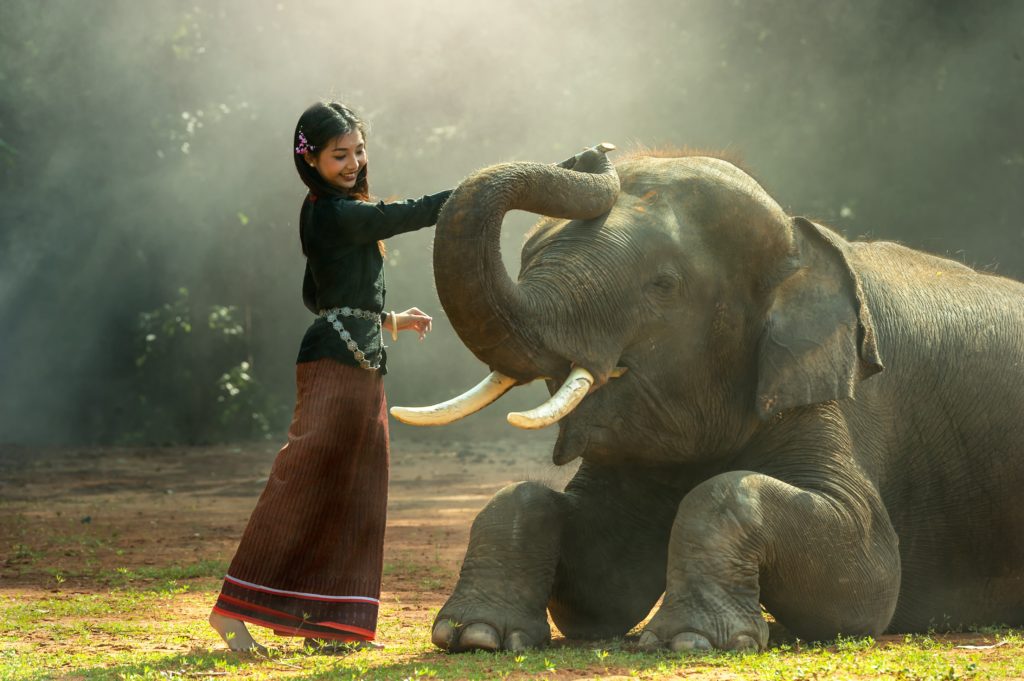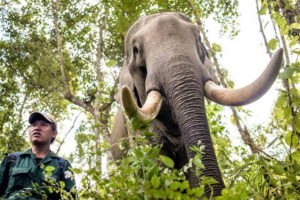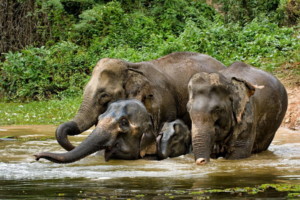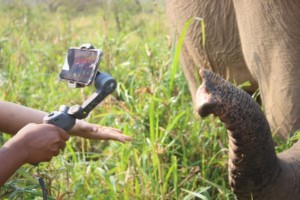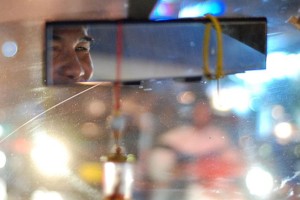Elephant tourism: The harms of received wisdom
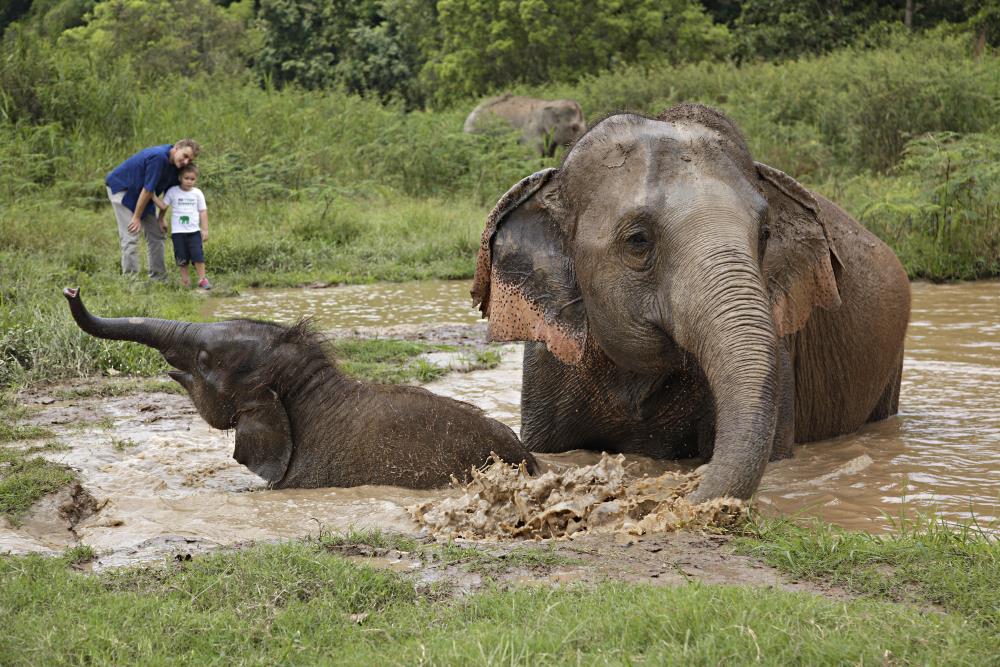
The “received wisdom” about elephant tourism that keeps conscientious travellers away from elephant-based attractions is doing more harm than good, according to elephant expert John Roberts in this “Good Tourism” Insight.
UPDATE, May 2021: “GT” asked Mr Roberts whether he would like to update this “GT” Insight from July 2017. In light of the circumstances in which captive elephants find themselves since the COVID-19 pandemic and associated travel & tourism depression took hold, Mr Roberts penned a new “GT” Insight: “Thailand’s tourism elephants lose when pragmatism gives way to politics, ideology”.
The last decade or so has been a very confusing time for anyone watching captive elephants in Southeast Asia. A tradition that has been a source of pride for the countries themselves and invoked a sense of awe in visitors for thousands of years has gone sour.
From the days when early explorers returned with incredible stories about these massive beasts and the people who could control them, when the armies of Alexander met them on the battlefield and the armies of Persia, Carthage & Rome, 500 years before Christ (1), hired and revered ‘Indians’ to control the elephants of their armies, mahouts may never have been the pinnacle of society but their skills were acknowledged and admired. They were accepted as people who were willing and able to do things and work with an animal that, in us laypeople, inspires both fear and love.
Mahouts’ fall from grace
But mahouts have fallen from this position of communal respect to a societal place where, to read some ‘news’ sites, internet pages and social media timelines, they are on a level with murderers; their deaths — particularly at the hand of their elephant — celebrated with the overall feeling that “they got what they deserved”.
In the space of a decade, about 0.3% of the time their tradition has existed, the received wisdom in the English-speaking internet and European world has shifted from awe and respect to the automatic assumption that a mahout is a cold-hearted torturer.
Working, as I do, with mahouts I think I can safely say that mahouts are not confused by this, in a large part because it manifests itself in languages other than those they speak and because, working everyday with elephants, they are still confident and proud in themselves and their skills and do not feel incentivised to change their ways.
But those who do operate in these languages — destination management companies, journalists, travel agents, tourism marketing bodies and, increasingly, elephant camp owners — can be forgiven for being confused.
A tour package that 10 years ago would have been sold out to rave reviews is now shredded, a target for actual hatred, on the internet. An advertising campaign that 10 years ago would have attracted thousands now discourages visits merely by having a picture of an elephant.
So what has changed? Not the tradition, the bare bones of which are the same. And not the situation as there are still some 3,480 elephants in captivity in Thailand alone (2) under the care of their mahouts.
What has changed for the worse is foreign, specifically English- and European-language-speaking, public perception. How does this happen?
![Elephant tourism: The harms of received wisdom 4 Mahout with a young elephant at Elephant Nature Park, Thailand. By Alexander Klink [CC BY 3.0 (http://creativecommons.org/licenses/by/3.0)], via Wikimedia Commons](https://goodtourismblog.com/wp-content/uploads/2017/06/1024px-Mahout_with_young_elephant-1024x683.jpg)
Truth and misinformation about elephant training
Firstly, there is a kernel of truth.
There are bad, aggressive, scared mahouts. And traditional methods for training elephants caught from the wild can be horrific, resulting in deaths from wounds or, years later, from stress. Data from Myanmar have shown that wild-caught elephants do not live as long as captive-born even after they get past the training and live ‘full’ lives (3). The modern world has no real place for captive elephants kicked out of their forests and forced to find the 250kg of food each elephant requires every day. Living cheek by jowl with humans means that they often end up in inappropriate places doing inappropriate things.
Secondly, there is a degree of misinformation.
Sometime prior to 2001 a concerned Thai citizen took a video of the training of a young elephant. Whether or not the calf was wild-caught, the trainers were using an horrific technique that we know, again from Myanmar, caused the death of between 12.4% (4) and 30.1% (5) of elephants that went through it.
When the video was released it immediately prompted the Thai Government to outlaw such training — or at least claim the outlawing of it as in practice there was little legal framework to do so. What they could do though was to ask the government department that had the most elephants, the Forest Industries Organisation, to investigate and develop more elephant-friendly training techniques, something they have been doing ever since.
Although taken with the best interests of elephants at heart, the video has had the capacity to do elephants a great deal of harm. This is due to the rise of the internet and a perhaps wilful human nature to focus on worst cases while ignoring science and rational argument.

Elephant tourism: The harms of received wisdom
Despite the fact that it is based on one video shot more than 20 years ago, it has become received wisdom that every elephant is trained in this fashion. This has never been true and is less true nowadays.
Furthermore, despite there being zero evidence from the past 3,500 years, it has become received wisdom that riding an elephant is inherently harmful.
This “received wisdom” effect is harmful not only because it is not true but also because:
- The group of people who 10 years ago would have visited an elephant camp with the education to spot abusive and harmful behaviour and the influence to encourage better practices are now not visiting. Because this demographic are now not visiting at all they are not a market demographic that most elephant camp owners figure to deal with anymore;
- There are at least 10,000 elephants in captivity across Myanmar and Thailand alone and the vast majority cannot be released back into the dwindling forests even if there were imperative to do so from within the country;
- Elephants are cripplingly expensive to keep and therefore must work or starve;
- The concerned tourists who have been persuaded to avoid elephants based on false accusations make up only a small percentage of the tourism industry whose share of Thailand’s GDP grew 10.7% (6) last year mainly on the back of inbound tourists from neighboring countries. In March 2017 more than 100,000 more tourists arrived in Thailand from China alone than from all of Europe put together (7) (the Europe figure includes Russia, the third largest source market, and the UK);
- Elephants and their mahouts who once enjoyed lighter work in the forest camps — camps that were preferred by the same visitors who have been persuaded to boycott them — now have no choice but to work in camps whose ownership is largely entrepreneurial, whose business model is to work elephants and mahouts harder than their competitors, and whose clientele are not yet concerned enough with animal welfare to inquire about the conditions in which elephants and mahouts are kept.
![Elephant tourism: The harms of received wisdom 6 A captive Asian elephant. Source: PJeganathan (Own work) [CC BY-SA 4.0 (http://creativecommons.org/licenses/by-sa/4.0)], via Wikimedia Commons](https://goodtourismblog.com/wp-content/uploads/2017/06/Captive_asian_elephant_JEG1453-e1498457164409-1024x550.jpg)
In short even good trekking camps, unless they have a special marketing strategy, are faced with little choice in a competitive market. They can either take shortcuts in the vastly expensive job of keeping elephants in order to compete with the scurrilous competition, or they can go out of business forcing their elephants to look for work elsewhere.
An out-of-work elephant, like an out-of-work mahout, still needs to eat. But because the forests are gone, the option to ‘go home and live free’ is not there. It is a good option and one to recommend where it can be achieved but the vast majority of the 10,000 captive elephants of Myanmar and Thailand don’t have it.
And staying at home under a valiant Government welfare scheme too often means 24 hours a day on a short chain, front legs shackled together. (8)
Either way it is the elephants that suffer now that the people with the power to do them good decide to avoid them altogether based on false assumptions.
References
- Elephants and Kings: An Environmental History, Thomas R Trautmann, University of Chicago Press, 2015 | ^ return to content
- Department of National Parks, Department of Livestock Development, Official Census, March 2017| ^ return to content
- Dr Khyne U Mar, Pers. Comm. | ^ return to content
- Burmese Timber Elephant, U Toke Gale, Trade Corporation, 1974 | ^ return to content
- “The Demography and Life History Strategies of Timber Elephants in Myanmar”, PhD Thesis, Khyne U Mar, University College London, 2007 | ^ referred to content
- Travel and Tourism: Global Impact and Issues, World Travel & Tourism Council, March 2017 | ^ return to content
- International Tourist Arrivals to Thailand March 2017, Ministry of Tourism & Sports| ^ return to content
- “Where do Unemployed Elephants End Up? (& can you change mahouts?)”, John Roberts, Elephant Tails Blog, 2016 | ^ return to content
Featured image (top of post): John Roberts and son walk with giants at Anantara Golden Triangle Elephant Camp & Resort.
What do you think? Share a short anecdote or comment below. Or write a deeper “GT” Insight. The “Good Tourism” Blog welcomes diversity of opinion and perspective about travel & tourism because travel & tourism is everyone’s business.
About the author

John Roberts saw his first captive elephant, Sham Shere Bahadur, on the lawn of Tiger Tops Jungle Lodge, Nepal, October 1, 1999. Despite being surrounded by many fascinating things in Chitwan National Park he was quickly fascinated by elephants, not only the creatures themselves but by the complex relationships with their mahouts.
Coming to Thailand in 2003 to manage elephants exposed John to a new set of challenges faced by elephants and their mahouts cut off from their jungle roots. He set up the award-winning Elephant Camp for Anantara Golden Triangle Elephant Camp & Resort, the first commercial operations to replace elephant saddles with bare back riding, and then the Golden Triangle Asian Elephant Foundation (GTAEF) to bring street-begging young elephants back to their natural habitat.
As well as helping wild elephants stay wild, GTAEF now concentrates on helping mahouts and elephants adapt to the realities of modern life in Southeast Asia. Core projects such as Target Training Positive Reinforcement Workshops have reached more than 200 mahouts, vets, and managers responsible for thousands of elephants across eight range states. Through partnerships with other organisations, GTAEF is providing the first full-time veterinary care to Southeast Asia’s most populous captive elephant site, home to the mahout tradition arguably most cut-off from it’s roots, Ban Ta Klang, Thailand. There they also provide children with full-time English training and conservation education.
UPDATE, May 2021: John is a member of the IUCN SSC Asian Elephant Specialist Group and co-chair of the Asian Captive Elephant Working Group. Since the start of the COVID-19 pandemic John, his GTAEF team, and the elephants have live-streamed nearly daily via Facebook at GTAEF Helping Elephants and Instagram at @GTAEF_Thailand.


